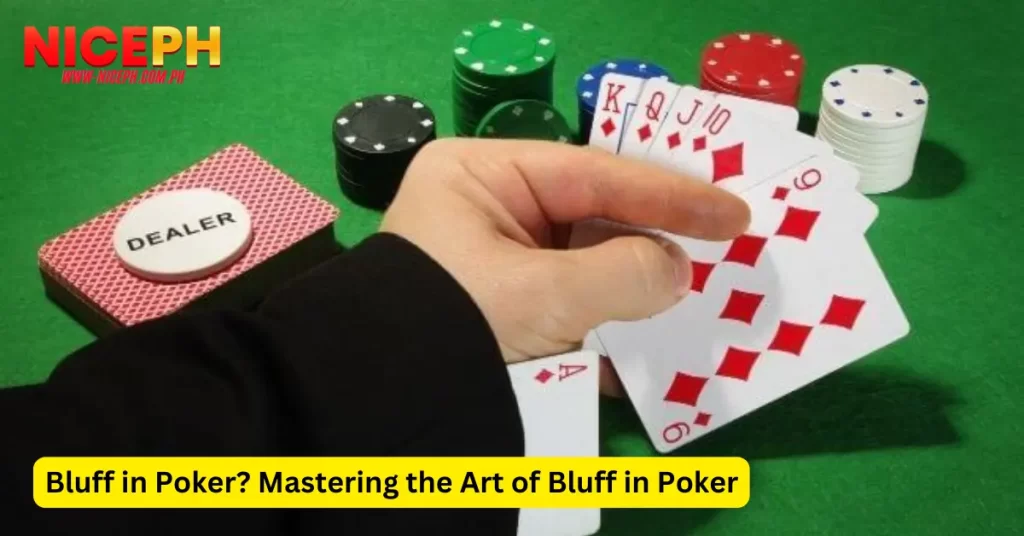Overview Bluffing in Poker
Bluffing is one of the most commonly employed tactics in card games played at casinos. When used at the right moment, bluffing in poker can be the decisive factor between winning and losing a hand in Texas Hold ’em.
In this guide, NicePH explores the importance of bluffing in poker and shares tips and techniques to help you execute it effectively.
What is bluffing in poker?
Bluff in poker involves attempting to force an opponent to fold their cards, even when they hold a stronger hand than yours. After all, you don’t need the strongest hand—or even a strong hand at all—to win the pot. The goal is to make your weak hand appear strong enough to pressure your opponent into folding.
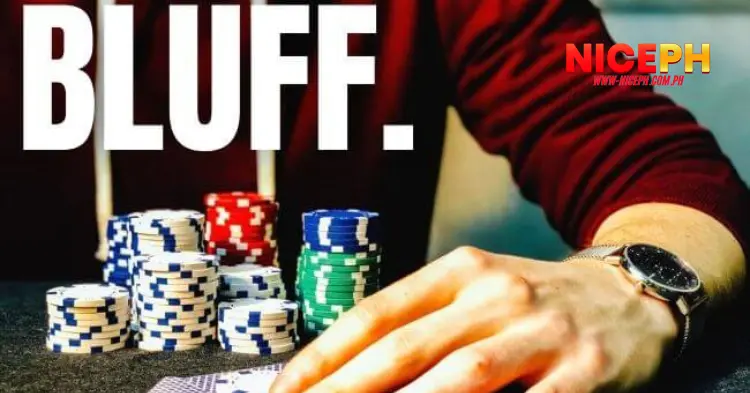
Depending on the situation, your opponent’s cards might coincide with yours, requiring you to decide whether to push them into raising or to maintain your aggressive stance. Essentially, bluffing involves betting significantly to intimidate opponents into making a wrong decision about their hand.
This tactic is distinct from value betting, which aims to minimize risk while extracting value. Bluffing strategies, while riskier, can lead to much higher returns.
Is Bluffing Really Necessary?
In short, bluffing is absolutely essential in poker. You can’t just sit and wait for strong hands for several reasons:
- Keeps the Game Engaging:
Waiting passively for the strongest hands makes the game dull and unexciting, both for you and other players at the table. - Prevents Predictability:
If you only play aggressively with strong hands, your strategy becomes predictable. Skilled players will fold whenever you bet, making it hard for you to extract value and leading to losses over the long run.
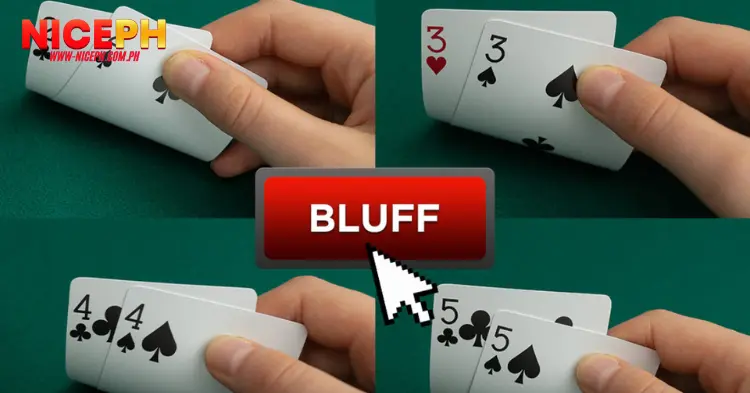
Even with good starting hands, you may fail to hit strong combinations on the flop or lose out to better hands by the turn or river. Winning pots consistently often requires bluffing to make up for weak hands or bad beats.
For example, imagine holding A-K before the flop and raising the bet. The flop brings Q-J-6, giving you a potential straight draw. You continue betting through the flop and turn but fail to hit the card you need on the river, leaving you with only an Ace-high.
At this point, you suspect you’re behind, but the only way to win is to bluff by betting or raising significantly. If your opponent folds, this is a classic example of a successful bluff.
Bluffing has been a staple of poker since the game was played in traditional European and American casinos centuries ago. While earlier techniques were more straightforward – players would simply lie about their hand strength – modern bluffing involves mastering facial expressions, body language, and betting patterns. Watching professional poker tournaments today, you’ll notice how difficult it is to distinguish truth from bluff, as all top players excel at concealing emotions and intentions.
=> Read more: Top Popular Variations of Online Baccarat at NicePH
Strategies for bluffing in poker
bluffing in poker is an art form, requiring players to force opponents to fold better hands. Unlike value betting, bluffing requires careful consideration and timing. Here are two key bluffing strategies:
1. Bluff Poker
The first and most straightforward strategy is bluffing outright, commonly applied during the river or flop rounds. The river is the most popular stage for this tactic because it’s the final betting round, and players can use an all-in bluff regardless of their hand’s strength.
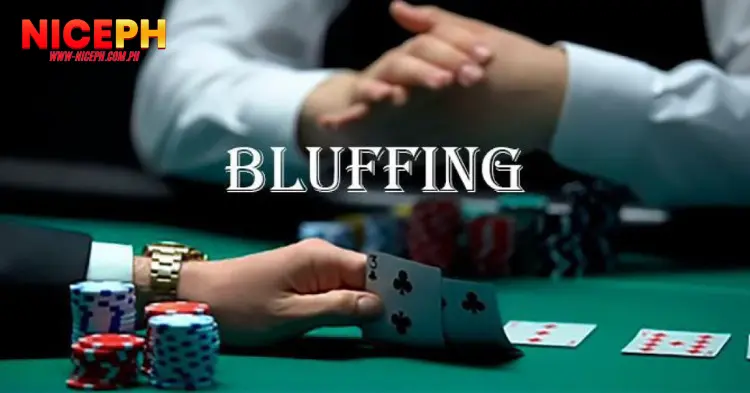
This move often creates significant pressure on opponents, leading them to believe that your hand is exceptionally strong and almost guaranteed to win. Even if they suspect a bluff, they might lack the confidence to call due to the risk of losing a substantial amount of money. In most cases, opponents choose the safer route of folding, allowing you to win the pot even with a weak hand.
2. Semi-Bluff
The semi-bluff is another effective strategy, particularly in earlier betting rounds like the turn or flop. Unlike pure bluffing, a semi-bluff is used when you still have a chance of improving your hand to a winning combination.

For instance, you might have a draw hand, such as a straight or flush draw, and decide to bet aggressively despite still needing to complete the hand. If you improve your hand by the river, you could win outright. If not, your aggressive betting might still force your opponent to fold.
Key Tips for Effective Bluffing
- Timing is Crucial:
Bluffing too frequently makes you predictable. Use it sparingly and strategically. - Know Your Opponent:
Pay attention to opponents’ tendencies. Some players are more likely to fold under pressure, making them ideal targets for a bluff. - Consider Your Table Image:
If you’ve been playing conservatively, a sudden bluff may appear more credible. On the other hand, if you’ve been overly aggressive, opponents might call your bluff. - Master Body Language:
Avoid giving away tells with nervous gestures or inconsistent betting patterns. - Bet Sizing:
Your bluff should match the narrative you’ve built throughout the hand. For example, a small bet may not convince opponents of a strong hand.
Bluffing is a critical skill in poker that separates casual players from seasoned pros. By mastering these strategies and tips, you’ll enhance your ability to control the table and win more pots, regardless of your actual hand strength.
=> Read more: How to Always Win at Baccarat – Tips from Experts
Benefits of bluffing in poker
Bluffing in poker offers numerous advantages for players who master and apply this skill professionally. While challenging to execute effectively, a well-timed and calculated bluff can provide the following benefits:
1. Creates Pressure on Opponents
Bluffing is an incredibly disruptive tactic at the poker table. No player wants to be deceived, and when they realize they’ve fallen for a bluff, they often feel frustrated or even angry. For example, if an opponent senses that your hand strength isn’t much better than theirs, a well-executed bluff can unsettle them, prompting premature folds. This hesitation and lack of confidence can pave the way for easy victories.
2. Improves Psychological Insight
In poker, reading an opponent’s mindset is fundamental but notoriously difficult to achieve. Using bluffing tactics sharpens your ability to interpret opponents’ psychological cues. During a bluff, you’ll notice changes in their behavior, betting patterns, and facial expressions, helping you build experience in understanding opponents’ emotional states over time.
3. Adds Excitement to the Game
Bluffing introduces tension, intensity, and intrigue to the game. It’s a moment when players start doubting one another and make diverse betting decisions. Additionally, bluffing requires focus, strategy, and sharp thinking, making the game more challenging and engaging for all participants.
=> Read more: The Most Common Baccarat Terms You Should Know
Common Mistakes in bluffing in poker
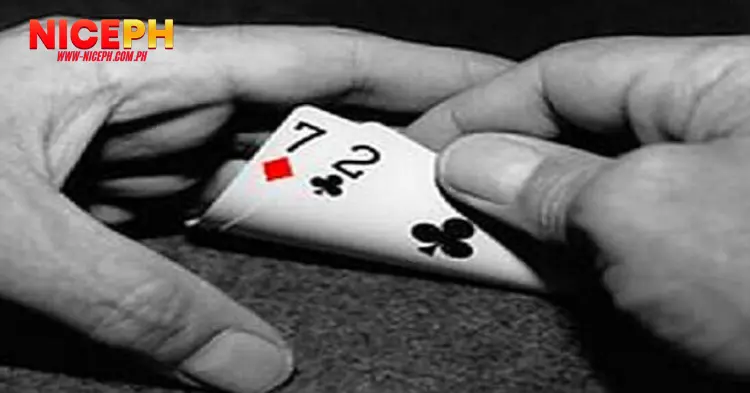
Bluffing is a skill that comes with risks, particularly for online casino beginners or players with limited experience. Here are some common mistakes to avoid:
1. Poor Timing
Bluffing is most effective during the river or flop rounds. Using bluffing at other stages can carry higher risks. Early in a game, players have already mentally prepared for potential losses, making an all-in bluff less likely to scare them into folding. Instead, choose strategic moments, such as the river, and avoid rushing into an all-in. Take time to assess opponents’ mindsets before committing to a bluff.
2. Misjudging Opponents’ Hand Strength
Bluffing requires an accurate read on your opponent’s cards. From the initial betting rounds, stay calm and analyze their betting behavior to gauge the relative strength of their hands. Bluffing without this insight increases your chances of losing.
For instance, if your opponent has a strong hand and you bluff, they’ll likely call you, leading to immediate defeat. Avoid bluffing in scenarios where you have no chance of winning, a situation known as bluffing with air. Trying to bluff when holding no outs or equity is often futile and results in unnecessary losses.
3. Overusing Bluffs
Another common mistake is bluffing too frequently. You may succeed once, but repeated bluffs within the same game or against skilled players rarely work. Poker is a game of logic, deduction, and probability. Bluffing excessively makes you predictable, allowing opponents to read your hand more easily. Once they catch on, they’ll call you out, leading to certain defeat.
=> Read more: Comparing Hilo and Sic Bo – Which Gambling Game Should You Play?
How to Bluff Effectively
To maximize your success with bluffing, follow these key guidelines:
- Know Your Opponents:
Study your opponents’ behavior and tendencies to predict how they’ll respond to a bluff. - Pick the Right Moment:
Only bluff when the timing and board dynamics align in your favor. - Set Clear Objectives:
Determine your goals and limits for bluffing within the game to avoid overcommitting. - Stay Composed:
Maintain a calm demeanor and avoid revealing your intentions through body language or betting inconsistencies.
By understanding and mastering bluffing techniques, you can gain greater control at the poker table. Bluffing is a powerful tool that, when used strategically, can help you dominate your opponents and increase your chances of winning.
=> Are you looking for a reputable and top-quality casino for betting? Try our partners: JIlibet.
Final Thoughts
bluffing in poker is an essential skill that every player should learn to enhance their gameplay. By knowing when and how to bluff effectively, you can outsmart your opponents and improve your odds of success. However, bluffing carries risks, so always exercise caution and adaptability.
NicePH wishes you the best of luck and plenty of fun at the tables!

